Occupational environment monitoring at the starch factory
99,000 ₫
Note: The above price is calculated for one sample, the price may vary depending on the area of the environment that needs monitoring and the movement of the market. For more accurate price support, please refer to the quotation table or contact directly with our consulting staff.
Environmental monitoring of a starch factory is a session of collecting, analyzing, and evaluating factors in the workplace that may harm workers health.
Table of Contents
Toggle1. Overview of Starch Production Factories
a. What is a starch production factory?
A factory for starch production is a manufacturing facility designed and specialized for processing food raw materials such as herbs, seeds, and tubers into starch. The starch production process aims to extract starch from raw materials and remove other components such as protein, fiber, and fat.
Starch production factories play an important role in the food industry and contribute to supplying high-quality raw materials for various food products.

b. Production stages in a starch production factory
In a starch production factory, the main production stages usually include:
- Raw material preparation: Raw materials such as herbs, seeds, and tubers are prepared and processed before further treatment. This includes peeling, washing, and removing impurities.
- Crushing: Raw materials are crushed into fine powder. This process helps separate starch from other components such as protein, fiber, and fat.
- Washing: The crushed starch powder is washed to remove remaining impurities and unwanted substances.
- Water pressing: The washed starch powder is pressed to separate starch from water. This process extracts starch from the solution.
- Settling and separation: The starch-containing solution after pressing is sent to a settling system to separate starch from water. Equipment such as filters or settling machines is typically used.
- Drying: The separated starch is dried to remove remaining water completely. Drying equipment can include rotary dryers, belt dryers, or other types of dryers.
- Fine milling: After drying, the starch may be milled to achieve finer and more uniform particle size. Milling machines are usually used for this purpose.

c. Machinery used in starch production factories
In starch production factories, several types of machinery are commonly used in processing stages. Some common machines include:
- Crusher: Used to crush raw materials into fine powder.
- Washing machine: Used to wash starch powder after crushing, removing impurities and residues.
- Water press: Used to press water out of starch, separating starch from liquid.
- Settling machine: Used to settle and separate starch from water after pressing.
- Dryer: Used to remove remaining water and dry starch. There are various types of dryers such as rotary dryers, belt dryers, continuous dryers, spray dryers, etc.
- Mill: Used to finely grind dried starch.
- Packaging machine: Used to package starch into bags or product containers.

d. Occupational diseases in starch production factory workers
Workers in starch production factories may suffer from some occupational diseases related to environmental and work factors. Some common occupational diseases in starch production include:
- Respiratory diseases caused by dust: Workers may inhale starch dust and fine particles during production, leading to respiratory issues such as pneumonia, bronchitis, dry cough, difficulty breathing, etc.
- Allergies: Continuous exposure to starch and chemicals during production can cause skin, respiratory, and eye allergies, resulting in itching, redness, rashes, or other symptoms.
- Bone and joint disorders: High-intensity labor or improper use of equipment may cause musculoskeletal injuries, such as back pain, spinal degeneration, arthritis, etc.
- Peripheral disorders: Workers may experience health problems like vision impairment, skin ulcers, burns, due to exposure to chemicals, high temperatures, or other external factors.
- Nervous system disorders: Working continuously in noisy, vibrating environments or exposure to chemicals may cause neurological issues like insomnia, fatigue, anxiety, depression, dizziness, etc.

e. Common types of starch on the market
There are many types of starch available on the market, used in various fields. Some common starch types include:
- Cassava starch: Extracted from cassava roots, used in food production, as an ingredient in bread, biscuits, ice cream, and other products.
- Potato starch: Extracted from potatoes, widely used in the food industry, including bread, biscuits, pastries, and as a thickener for sauces and yogurt.
- Corn starch: Made from corn kernels, used as a thickener and sweetener in food products such as bread, biscuits, soft drinks, and frozen foods.
- Tapioca starch: Derived from cassava, widely used in food production, including noodles, desserts, beverages, and confectionery.
- Rice starch: Made from rice, commonly used in Asian cuisine for cakes, pancakes, buns, and desserts.
2. Overview of occupational environmental monitoring services
a. What is occupational environmental monitoring in starch production factories?
Occupational environmental monitoring (or workplace environment measurement) in starch production factories is the activity of collecting, evaluating, and analyzing measurements of workplace environmental factors in starch production factories to take timely measures, minimize environmental impacts on worker health, and prevent occupational diseases. Occupational environmental monitoring is mandatory for starch production factories.
Monitoring plays a critical role in caring for, protecting, and enhancing worker health because employees are the primary workforce of a company and directly generate its profits. Workers frequently exposed to hazards or harmful occupational factors above permissible limits can suffer health consequences and develop occupational diseases.
REGISTER FOR OCCUPATIONAL ENVIRONMENT MONITORING SERVICE
b. Nam Viet’s occupational environmental monitoring program
Nam Viet’s occupational environmental monitoring program is designed by monitoring engineers specializing in occupational safety and environmental protection. With the goal of ensuring worker health and safety, the program uses modern measurement methods to monitor air quality, water, microclimate factors, physical factors, dust, and more in the workplace. This program is essential for ensuring a safe working environment and protecting worker health.
Additionally, Nam Viet’s program is important for researching and developing new solutions to improve workplace environmental quality. With the dedication and professionalism of the monitoring experts, An Toan Nam Viet’s exclusive monitoring program represents a breakthrough in occupational safety and environmental management in Vietnam.

c. Standardization in workplace environmental measurement procedures
Standardization in An Toan Nam Viet’s workplace environmental measurement procedures is crucial for ensuring accurate and reliable results. To ensure precision and reliability, the program follows recognized standards and procedures of the Ho Chi Minh City Department of Health. This ensures that collected data can be reliably used in workplace environmental assessments and decisions to improve the working environment and protect worker health.
These standardized procedures also ensure that measurements are performed by highly qualified monitoring professionals with many years of experience, enabling managers and experts to trust the results from An Toan Nam Viet and make accurate, valuable decisions for worker health and environmental protection.
By applying standardized procedures in environmental measurements, An Toan Nam Viet demonstrates its commitment to ensuring a safe working environment and protecting worker health, while actively contributing to improving occupational safety and environmental management in Vietnam.
d. Starch factory monitoring report
Occupational environmental monitoring results are prepared according to Form 04, Appendix III, issued with Decree 44/2016/ND-CP and prepared in two copies: one copy sent to the enterprise that contracted the monitoring service, and one copy kept by the monitoring organization.
The retention period for occupational environmental monitoring results is indefinite, as regulated by law.

e. Frequency of occupational environmental monitoring as required by law
According to Clause 2 of Article 18 of the Law on Occupational Safety and Hygiene 84/2015/QH13, employers must organize workplace environmental monitoring to assess harmful factors at least once a year.
f. Deadline for submitting occupational environmental monitoring reports as required by law
The deadline for submission is before December 31 each year. Enterprises in mandatory production factories must submit occupational environmental monitoring reports to the local Department of Health where the facility has its main office and where workers are employed.
When there are changes in technology, production processes, or upgrades to facilities that may introduce new harmful factors affecting worker health, enterprises must update occupational hygiene records regarding harmful factors that require monitoring.
g. Penalties for violations of occupational environmental monitoring by employers
According to Article 27 of Decree No. 12/2022/ND-CP dated January 17, 2022, regulating administrative penalties in labor, social insurance, and Vietnamese workers working abroad under contract:
- Clause 2: Fines from 2,000,000 – 5,000,000 VND for employers who fail to publicly disclose monitoring results to employees at the monitored workplace and areas where hazardous factors are controlled immediately after receiving monitoring results and evaluations.
- Clause 3: Fines from 20,000,000 – 40,000,000 VND for employers who do not conduct environmental monitoring to control health hazards according to the law.
- Clause 4: Fines from 40,000,000 – 60,000,000 VND for employers who cooperate with environmental monitoring organizations to commit fraud in monitoring activities, without reaching the level of criminal liability.
3. Harmful environmental factors for workers in starch production factories
In starch production factories, there are several environmental factors that can be harmful to workers. Below are some of the main factors:
- Dust: The starch production process can generate dust from handling, grinding, and processing starch. Starch dust can cause respiratory irritation, rhinitis, pneumonia, and other respiratory issues.
- Chemicals: During starch production, chemicals such as bleaching agents, disinfectants, softeners, and other additives may be used. Exposure to these chemicals can cause skin irritation, allergies, and other health problems.
- Temperature and humidity: Starch production may require specific temperature and humidity conditions. Working in high temperature or overly humid environments can cause fatigue, discomfort, and affect workers’ health.
- Noise: Machinery and equipment in starch production factories often generate high levels of noise. Noise not only causes discomfort and psychological stress for workers but can also damage hearing and lead to related health issues.
- Machine safety: Using machinery and equipment during starch production can be hazardous and cause accidents if safety rules are not followed. Workers may be exposed to risks from mechanisms, sensors, conveyors, and other equipment in the factory.
REGISTER FOR OCCUPATIONAL ENVIRONMENT MONITORING SERVICE
4. Measures to improve the working environment in starch production factories
To improve the working environment in starch production factories, the following measures can be applied:
- Dust management: Use effective dust extraction systems and dust-proof equipment to limit dust dispersion during production. Ensure regular cleaning and maintenance to remove dust.
- Use safe chemicals: Select and use bleaching agents, disinfectants, and additives that are safe, environmentally friendly, and non-harmful to workers’ health.
- Adjust temperature and humidity: Ensure appropriate temperature and humidity conditions in the factory to create a comfortable and safe working environment for workers. Use air conditioning and ventilation systems to maintain ideal environmental conditions.
- Noise control: Implement soundproofing and insulation measures in the factory to reduce noise from equipment and machinery. Additionally, provide ear protection equipment for workers to safeguard their hearing.
- Ensure machine safety: Perform regular inspection, maintenance, and repair of machinery and equipment in the factory. Ensure machines operate properly and comply with safety regulations. Train employees on safe machinery use and accident prevention measures.
- Training and awareness: Provide occupational safety and health training for workers in the factory. Raise awareness about potential hazards and ways to prevent occupational diseases. Encourage participation and adherence to safety rules by all staff.
- Continuous evaluation and improvement: Conduct regular workplace assessments to identify potential issues and risks. Apply continuous improvement measures to enhance working conditions and protect workers’ health.
- Periodically conduct occupational environment monitoring in factories, collecting and analyzing harmful factors for workers, and adjust measures to reduce risks and prevent occupational diseases.
5. Benefits of periodic monitoring in starch production factories
An Toan Nam Viet provides enterprises with excellent benefits when using occupational environment monitoring services according to Decree 44/2016/NĐ – CP on managing and controlling harmful factors in the workplace that affect workers.
- Enterprises can proactively control harmful factors in workshops or factories.
- Receive recommendations on measures to reduce harmful factors and improve the quality of the working environment.
- Indirectly protect human resources, a key factor in enterprise development.
- Reduce the impact of occupational diseases on human health, thereby minimizing future treatment costs.
- Improve worker health, leading to better product quality and stable production output.
- Ensure compliance with labor safety regulations and avoid legal risks.
- Enhance credibility and professionalism in all aspects, elevating the enterprise’s brand.
Nam Viet’s environmental monitoring service is a solution to reduce the impact of occupational diseases, contributing to a healthy and quality working environment.

6. National occupational environment monitoring center
Nam Viet Occupational Environment Monitoring Center is a professional unit specializing in monitoring and measuring occupational environment quality across all provinces in Vietnam. With an experienced team of monitoring specialists, the center uses modern measuring equipment to ensure accuracy and reliability.
In addition to monitoring services, the center assists clients in planning, managing, and tracking occupational environment issues. With the motto “customer-centered,” the center prioritizes customer satisfaction, meets all client needs, and is committed to providing the best solutions for enterprises.
REGISTER FOR OCCUPATIONAL ENVIRONMENT MONITORING SERVICE
With investments in technology, equipment, and human resources, Nam Viet’s monitoring center has become one of the most reputable units in occupational environment monitoring in Ho Chi Minh City, with the following objectives:
- We always value our brand reputation and the quality of our service products.
- We provide clients with the best and most suitable solutions possible.
- Along with a team of experienced Masters and Engineers, aiming to protect the environment and benefit enterprises.
- By working with Nam Viet Environmental Monitoring Team, companies will receive professional service from experts in the field and enjoy the best cost advantages.
The occupational environment monitoring process at Nam Viet includes the following basic steps:
- Before monitoring, ensure all machinery and equipment are calibrated and adjusted according to legal regulations.
- Strictly follow the occupational environment monitoring procedures as committed to the Department of Health.
- Accurately report monitoring results to employers.
- If monitoring results indicate unsafe conditions for workers, Nam Viet will provide remedial solutions, and the workplace will implement the following:
- Implement measures to improve working conditions to minimize the impact of harmful factors and prevent occupational diseases.
- Organize health check-ups to detect occupational and work-related diseases early for workers in unsafe environments.
- Provide allowances in kind for workers according to labor law regulations.

7. Occupational environment monitoring service quotation
To help enterprises perform occupational environment monitoring professionally and effectively, Nam Viet provides clients with a detailed quotation for occupational environment monitoring services with quality and reasonable cost.
- Our quotation provides detailed pricing for the monitoring services we offer, including costs related to transportation, measurement, analysis, and reporting. Clients can fully trust the accuracy and reliability of the monitoring reports we provide.
- We are committed to offering the most competitive and reasonable prices on the market, and we are always ready to provide prompt and professional consultation on monitoring services.
- With Nam Viet’s quotation, clients can easily select service packages that meet their needs. We are committed to delivering the highest satisfaction with professional service quality.
No comments yet

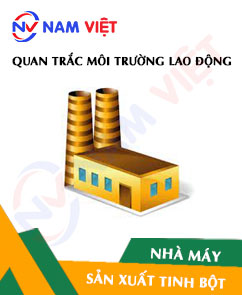
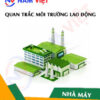
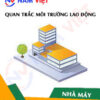
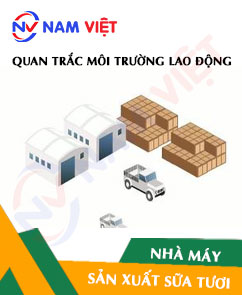






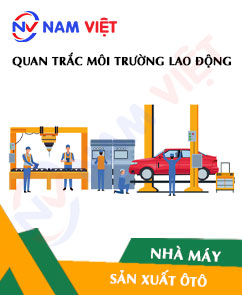
Review Occupational environment monitoring at the starch factory
There are no reviews yet.